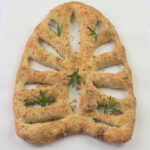Description
This Sourdough Asiago Herb Fougasse, crafted with an overnight levain, incorporates a blend of all-purpose, spelt, and rye flours, and is generously infused with Asiago cheese and rosemary. Before baking, the flatbread is brushed with olive oil, and sprinkled with extra rosemary and Parmesan cheese, creating a perfect harmony of flavors and textures.
Ingredients
Units
Scale
Levain:
- 100 grams water
- 100 grams all-purpose flour
- 27 grams sourdough starter (from the fridge)
Dough:
- 200–260 grams all-purpose flour, divided
- 75 grams whole grain spelt flour
- 25 grams whole grain rye flour
- 180 grams water
- Levain, all of the above
- 1 tablespoon olive oil
- 6 grams (1 tsp) fine sea salt
- 2 –3 Tbsp. fresh rosemary, finely chopped, divided
- 75 grams Asiago cheese
Toppings:
- Parmesan cheese, or additional Asiago cheese
- Fresh rosemary, finely chopped
- Coarse sea salt, optional
Instructions
Mixing:
- In the bowl of a stand mixer, place 200 grams of all-purpose flour, 75 grams spelt, and 25 grams rye flour and 180 grams of water. Mix on low speed to combine. Cover, and let the flour/water mixture rest (autolyse) for 30 minutes to 1 hour.
- Add the levain, and 1 tablespoon of olive oil. Mix on low speed until thoroughly incorporated. Add in additional all-purpose flour as needed (up to 60 grams), until the dough clears the side of the bowl. You should be able to pull a “window pane” by gently stretching the dough. Let the dough rest 20 minutes.
- Add the salt, and mix on low speed, until the dough is smooth. Add in the Asiago cheese and 2 tablespoons of rosemary, the remaining rosemary will be used for sprinkling on the top. Mix on low speed until just incorporated. Optionally, knead in the cheese and rosemary by hand on a lightly floured counter.
Bulk ferment:
- Form the dough into a ball. Oil a large bowl (not metal) and turn the dough ball in the oil to coat. Cover with bees wrap or a plastic produce bag, and place in a warm place.
- Let the dough rise for 2-3 hours. After the first hour, gently press the dough to remove excess gas. Form it back into a ball and place it seamside down in the bowl.
- Let the dough rise for an additional 1-2 hours.
Shaping:
- About an hour or so before baking the fougasse, turn the dough out of the bowl onto a lightly floured surface, and fold the dough over itself. Let it rest on the counter for 20 minutes.
- Divide the dough into two pieces weighing about 425 grams each. Note: Cut the folded dough right down the middle, lengthwise, to make things easy.
- To make the leaf shape, use wet fingers to press the dough out into a tall triangle (about 10-11-inches on a side and 1/2 – 1-inch high). Place the shaped dough onto a piece of baking parchment (on a baking sheet).
- Using a bench scraper or stiff plastic dough scraper or something similar, cut into the dough to make leaf ‘veins’. Use your fingers to gently spread out the dough to open up the cuts. Keep the leaf shape. Repeat if desired with the other piece of dough, or store the remaining dough, covered, in fridge, until ready to use. The dough will last in the refrigerator for 24-48 hours.
- Cover with a kitchen towel, and let rise for about 30 minutes to an hour, or longer depending on the temperature of your kitchen. The leaf will get puffy. If the holes close up, gently open them again with your fingers prior to baking.
Baking:
- While leaf is rising, preheat the oven to 425 degrees F. with an iron skillet, or other steam pan, on the lowest rack of the oven, a baking stone or steel on the shelf directly above that, and a baking stone on an upper rack (2 racks above the baking steel). If you only have one baking stone, place it on the middle rack with a steam pan on a lower rack.
- Using a pastry brush, lightly brush the surface of the leaf with olive oil, then sprinkle with chopped rosemary, sea salt, and Parmesan cheese.
- Carefully slide the loaf (still on the parchment) off of the baking sheet and onto the baking stone on the lower shelf. Note: I usually turn the parchment so that it’s width wise on the baking sheet. This makes it easier to slide onto the baking stone.
- Immediately place 1 cup of ice cubes in the iron skillet (steam pan). Bake the loaf 7-9 minutes on the lower rack. Rotate and move the loaf up to the baking stone on the upper rack and bake for an additional 8-10 minutes. The loaf should be golden brown. You can bake it darker, but if you add cheese, remove it before the cheese burns.
- Serve while still warm, breaking off pieces of the leaf, or cutting into portions.
Notes
Options for toppings include cheese, nuts, herbs, citrus peels, olives, etc.
- Category: Fougasse
- Cuisine: French Bread
